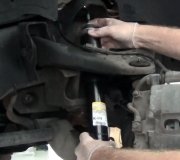You got it right. Camber is the tilt in or out on top as viewed from the front. Each tire must be set to specs to prevent excessive wear on the inner or outer edge, and, a tire wants to roll in the direction it's leaning. For that reason both tires must be set the same but with the left one leaning out just a little more to make up for "road crown". That is the road leaning to the right so rain runs off.
When you look at the ball joints from the side of the truck, caster is the upper ball joint is further back than the lower one. That makes the spindle sit at an angle much the same as a bicycle fork goes forward as it goes down. 0 degrees caster means the upper ball joint is directly over the lower one. If you could imagine the upper joint straight behind the lower one, that would be 90 degrees caster. In reality, 3 to 4 degrees caster is typical. The exact value isn't critical because it isn't much of a tire wear angle but it's more important that both sides are the same. When you put weight on the bicycle wheel that angle is what makes the tire go straight and you can ride no-handed. On a car, since the weight is on the side of the wheel, when putting the weight on the right tire, caster makes it want to flop to the left. 3 degrees caster will make it flop in so hard you won't be able to pull it back straight by hand because doing so also raises the corner of the vehicle a little. That can be over 1000 pounds you're lifting. The idea is the other wheel is doing the same thing. When you connect a steering linkage between the two wheels they counteract each other much like a balanced teeter totter. Caster can also be increased slightly on the right to make it flop in harder than the left side to offset road crown.
Camber is pretty easy to set because it takes a big adjustment to make a small change. It's easy to sneak up on the desired setting. Caster is harder to set accurately because the slightest adjustment makes a big change in the numbers. That's why having a dedicated adjustment for just caster makes it easy to match one side to the other.
Saturday, March 12th, 2011 AT 4:56 AM


